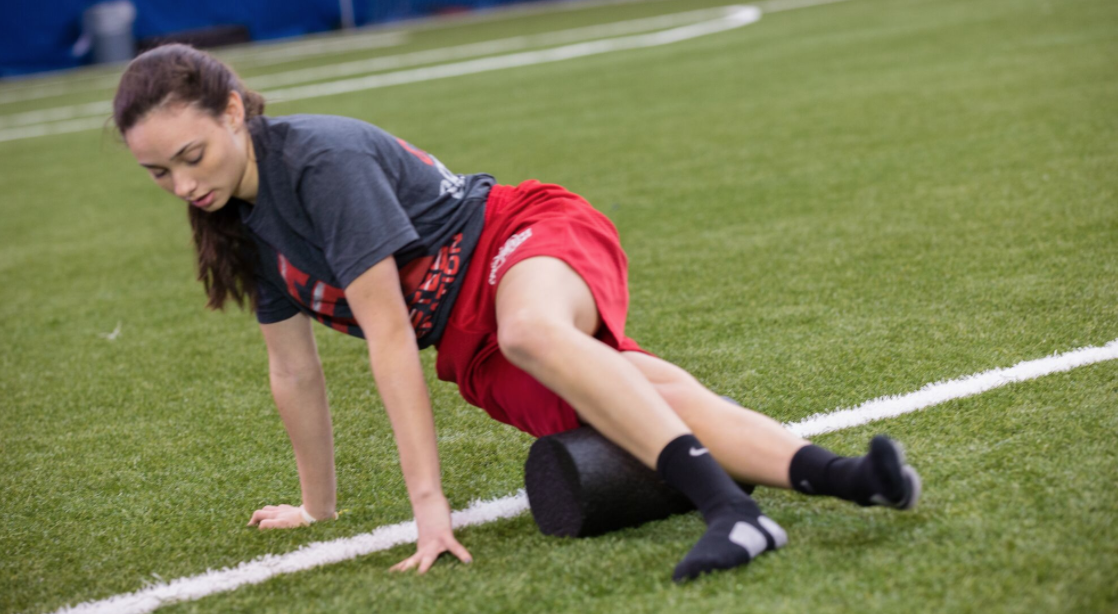Warm Up Your Basketball Workouts
By: Glenn Harris

For ten of the eleven years that I have been at Boston University, I have had the opportunity to work as the head strength and conditioning coach. During this time, I have continually tried to modify and improve the training programs in order to design a program which will create the desire results of improved flexibility, speed, conditioning, and strength.
The sport of basketball is a highly technical game involving excellent hand/eye coordination however it is also a game that involves a tremendous amount of conditioning. However, before any competition or conditioning can begin it is my job to make sure that the team is thoroughly warmed up and ready to play. Therefore, the intent of this article is to outline and describe the various warm-up and flexibility routines that I have the basketball team at Boston University perform before games, practices or workouts begin.
The Program
Each training session is divided into Pre-Warm-up, Warm-up, Speed/Plyometric/Agility, Core, Conditioning, Strength Training, and static stretching. This article’s focus will be on the first two topics: Pre-warm-up and Warm-up.
Pre Warm-up
Prior to every workout, 10 minutes of self myofascial release is performed. This is performed by rolling the body on a high density foam roller. The benefit of performing the foam roller routine is to break up any adhesions in the muscles that may build up during previous workouts. The designed routine is not set up for a specific amount of repetitions for each muscle groups. Instead, the athletes determine the amount of rolling they do on the muscles depending on the amount of soreness that they feel. For example, more attention may be needed on the hamstrings on one day and the shoulders may need more attention on the next day. The athletes begin with rolling the glutes and periformis. Next, they work their way down the hamstrings, gastrocs, and soleus. After they feel that they have adequately rolled the posterior leg, they turn over and begin with the anterior side. They start with the tibialis anterior and then work their way up the quadriceps and iliotibial band, tensor fascia latae and leg adductors. After the lower body has been rolled out, we move the foam roller to the upper body. I will have the athletes start at the lower back and then progress up to the shoulders and arms. After focusing on the shoulders, the athletes will turn over and we will focus on the anterior deltoids as well as the pectoralis area.
Warm-up
After the foam roller session, the workout moves onto the warm-up. Depending on the day, the workout will list either a form running focused warm-up called the continuous warm-up or and agility focused workout using an agility ladder.
The continuous warm-up is a series of dynamic movements that are done in a 10-20 yd area. They are performed continuously with little rest from drill to drill. The main emphasis for this warm-up is to have the athletes raise their body temperatures to warmup the muscles for the ensuing workout. The continuous warm-up is performed prior to practices and games as well. The warm-up is made up the following:
High Knee Walk: Lift the knee up and pull the knee towards your chest without leaning forward with your upper body.
High Knee Skip: Integrating the upper and lower body coordination. Easy skipping to begin to loosen up the body.
High Knee Run: Flexing the hips as fast as possible. We are not trying to work on “running”. We are trying to warm the athlete’s body temperature.
Butt Kicks: Flexing the knees as fast as possible and trying to bring the heels up to the buttocks.
Straight Leg Walk: A great dynamic stretch for the hamstring. The movement is done holding the hands out in front of the body and then trying to kick the feet towards the hand.
Backwards High Knee Skip: Done similar to the High Knee Skip except backwards.
Backwards Run: With a forward body lean, the athletes run backwards.
Carioca: Involving lateral front to back steps. This movement focuses on the lower back and hips.
Defensive Slide: Warms up the Ad- and Ab-ductors of the legs.
The agility ladder warm-up is a group of exercises that is intended to work on the athletes foot skill and lower body coordination. The warm-up that I have the players perform is by no means the only exercises that can be performed using the agility ladder. One of the great things that the agility ladder allows strength coaches is the freedom to invent new drills. For our routine, we have an eight exercise set. The drills that are made up for the agility ladder are named in a way that the athletes can figure them out with somewhat ease.
Quick Feet: The athlete tries to move through the ladder as quickly as possible, stepping one foot in each square of the ladder. This drill is performed forward and laterally right and left.
Shuffle Quick: Starting outside the ladder on one foot, the athlete will shuffle across the ladder quickly, stepping into a square with both feet and then ending on one foot on the other side of the ladder before returning to the other side again. This drill is performed forward and backward.
In In Out Out: Starting by straddling the ladder with the feet, the athlete will then step in with each foot and then out with each foot. “In In Out Out” This drill can be performed forward, backward, and laterally.
Can-opener: Starting with one foot in the ladder, the athlete will move laterally across the ladder keeping that foot inside the ladder squares while not having the the other foot step in the ladder. This can be done with the front foot and the trail foot. When performing this drill we think of one of those old manual “can-openers.”
Cross-over In Front: Starting with both feet outside of the ladder, the athlete steps into the ladder with the outside foot stepping IN FRONT of the other foot. Then will step out of the ladder on the other side with both feet. This drill is performed forward and backward.
Cross-over Behind: Starting with both feet outside of the ladder, the athlete steps into the ladder with the outside foot stepping BEHIND the other foot. Then will step out of the ladder on the other side with both feet. This drill is performed forward and backward.
Scissors: Starting with one foot in the ladder then switch feet in the ladder. Repeat the foot switching as the athlete moves laterally.
Hop Scotch: Begin with both feet straddling the ladder then hop to one foot in the ladder. Repeat through the ladder while alternating feet that land inside the ladder squares.
Dynamic Stretch
After the warm-ups are completed, the team performs a dynamic stretching movement that I learned from Mark Verstegen, Director of Athlete’s Performance in Arizona. We call it the Spiderman/Hamstring stretch. Starting in a push-up position, the athlete will step with one foot, bringing the knee up toward the shoulder/armpit area. From that position, the athlete will lower the elbow of that arm down attempting to have the forearm down on the ground. Once down there, they will attempt to straighten that front leg to direct a stretch onto the hamstring. At the same time, they will try and put the heel of the back foot onto the floor causing a stretch to the opposite Achilles area. Next they will return to the push-up position and start on the opposite leg. This will be repeated ten times.
Summary
Proper preparation for workouts and games is important for success. At Boston University, the basketball team prepares for each practice, workout, and game with a similar routine involving a dynamic and functionally specific warm-up that prepares each player for the demands of the ensuing session. Not only will it benefit the athletes from increasing alertness, it will also help decrease the chance of injury.
Recommended Athletes' Acceleration
Products
About The Author:
Glenn Harris is the Head Strength and Conditioning Coach for the Boston University Terriers. He has he supervised the strength and conditioning regimens for the 1996-97 America East champion men’s basketball, field hockey and men’s soccer teams. He also trained members of the 2004 U.S. women’s soccer team. In addition, he conducted classes with student athletic trainers, which emphasized the practical applications of strength and conditioning research.
Harris has authored several articles involving strength and conditioning and is a Certified Strength and Conditioning Specialist by the National Strength and Conditioning Association and also holds a Club Coaching Certification by the U.S.W.
For more information on Coach Harris and the Boston University Strength & Conditioning Program go to: http://www.bu.edu/athletics/sass/strength-conditioning.html




0 Comments for “Warm Up Your Basketball Workouts”